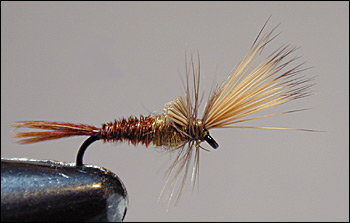
On The Fly
"Fly tying is a school from which we never graduate"
TYING NEWS
The Southern Oregon Fly Tiers met Wednesday, Febraury 14th
at the library in Gold Hill. There was a lengthy discussion about
alternative meeting locations should the library close on April 7th as
planned. If anyone has suggestions please contact me ASAP. Members did not
exchange valentines but did have a fly exchange. We encourage novice and
experienced tiers alike to drop by for a fun evening. The next meeting will
be on March 14th.
We had a great turnout for the RFF tying classes this
year. Each of the three groups was filled to capacity with eager students.
Thanks to Rusty at the Silver Sedge Fly Shop in Merlin for the generous
discount on materials. Special thanks go to Johnny Hale and Dale Heath for
volunteering their time and efforts to instructing classes.
Many local tiers are making preparations for the upcoming
Northwest Fly Tiers Expo on March 9th and 10th. There will be up to 300
tiers at this unique two-day event, which also includes vendor booths
featuring the latest tying and fishing gear. Ask anyone who has ever
attended this Expo, it’s worth the trip.
 PATTERN OF THE MONTH - Baetis Cripple
PATTERN OF THE MONTH - Baetis Cripple
Hook: Standard dry, TMC 100 or equal. Sizes 16-20.
Thread: Brown 8/0.
Tail: Pheasant tail fibers.
Abdomen: Wrapped pheasant tail fibers.
Thorax: Olive or brown Superfine dubbing.
Wing: Tan deer hair.
Hackle: Olive Grizzly.
Tying Instructions:
1) Start the thread one eye-length behind the eye. Wind a thread base back
to just above the barb.
2) Tie in about 5 or 6 pheasant tail fibers on top of the hook shank. Tail
should be ¾ the body length. Do not trim the butt ends.
3) Advance the thread forward to the thorax position and let the thread
hang. Wind the butts of the tail fibers forward in tight turns to the
thread position.
4) Dub the thread with the Superfine dubbing and wind it forward to form
the thorax, ¼ body length.
5) Select a small bunch of deer hair, stack it to even the tips, measure
one body length and tie in the deer hair with the tips facing forward over
the eye of the hook. Post up the wing at 45 degrees forward with wraps
behind and in front. Clip the butts to extend back just over the thorax.
6) Tie in the hackle feather behind the wing, wind the feather forward
three turns, and tie it off.
7) Form a whip finish in front of the wing and apply cement.
The “cripple” patterns, created by our own Bob Quigley,
imitate several species of mayfly that become stuck in their shuck while
emerging. If this happens, trout recognize the vulnerable condition and key
in to feed on cripples when they see an easy meal. Often times during a
good hatch your fly can get lost in the thousands of natural insects on the
water. A cripple pattern is an excellent way to entice trout to take your
fly.
The Beatis Cripple dressing is in the “Quigley” style and
represents a crippled blue-winged olive mayfly. Blue-winged olives come in
body colors that range from olive to brown. Choose a color that matches the
natural available to trout when and where you are fishing. Dress only the
front half with floatant so the back half sinks below the surface and use
standard dry fly presentations. So tie some up, give them a test flight,
and let me know how you do.
TYING TIPS
Select pheasant tail fibers long enough for both the tail
and the abdomen. These longer fibers can be found most often on center tail
feathers. To achieve a tapered body on your fly, you should overlap the
fibers as you wind forward. Deer hair has a tendency to flair and roll
around the hook shank. To prevent this problem, hold the bunch firmly over
the tie-in point and take at least one full soft wrap before cranking on
the thread. The butts of the deer hair represent the cracked shuck of the
emerger. Proper trimming to length is an important factor so watch your
proportions and don’t crowd the head.
Tie One On,
Dan Kellogg (you can contact me at FLYGUY@EZNORTHWEST.COM)